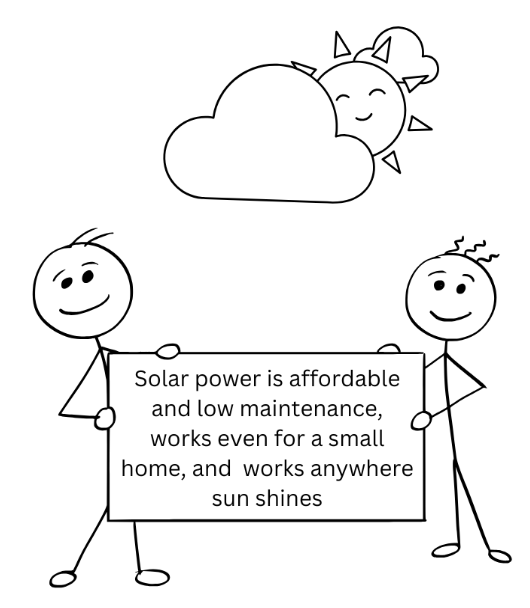Themes in this post: Modularity | Scalability | Ease of installation | Affordability | Maturity | Mother source
If you had been at Cape Canaveral in the US on 17th March 1958, you would have witnessed a spacecraft weighing just 1.5 Kg put into orbit using a three-stage launch vehicle. Vanguard 1 was not the first artificial satellite to be successfully launched – that honour belongs to Sputnik 1 launched the earlier year by the erstwhile Soviet Union. But it was the first ever man-made satellite to be solar powered – it had six small solar cells that together produced an aristocratic 1 watt of power.
The team putting together the satellite was not sure how well the solar cells would perform, so they also added a battery. Just weeks into orbit, the battery stopped operating, but the solar cells merrily continued producing power for years, helping the transmitters to convey to earth a number of findings.
Solar cells had proved their enduring value almost seventy years back!
Solar is perhaps the most “powerful” of all renewable energy technologies. I will tell you why.
Modularity
Solar photovoltaic technology is modular, and this is a key strength
I’d rate modularity as perhaps solar PV’s strongest asset. You can have a solar cell that is just a watt, you can have a mega solar park that is 1,000,000,000 watts (yes, there are solar farms this large – and larger – already), you can have all the sizes in the middle, and almost all of them work at the same efficiency. That’s quite a remarkably useful thing really, modularity.
The modularity of solar PV gives rise to a number of derived strengths.
Scalability
Because a solar power generating unit can be as small as something on the back of a calculator to a massive solar farm that occupies 1000 hectares, solar power can be generated from diverse environments
As a renewable energy source, sunlight is something that happens at scale – most parts of the world have access to sunlight for most of the year.
One of the significant advantages of solar energy is its versatility in deployment across different geographic regions and environments. Unlike wind and hydroelectric power, which require specific conditions like high wind speeds or significant water flow, solar energy can be harnessed in a variety of settings, making solar energy applicable from urban rooftops to remote rural areas.
Solar panels can be adapted to a wide range of sizes and settings, from small residential systems to large utility-scale solar farms. This flexibility makes it an ideal solution for both local and global energy needs.
Solar power plants can be deployed both in dense urban environments and in remote rural settings. As solar power plants can also operate in offgrid mode (where the grid is not needed), small solar power plants can also provide electricity to remote rural regions.
While we mostly hear about large-scale solar farms in mainstream news, small scale, distributed solar power installations mainly in the form of rooftop solar and in some cases offgrid solar power plants have also grown quite well since 2010 – around the world, and in India.
Ease of installation
A key reason solar PV requires very little maintenance because it has no moving parts – something that cannot be said for most other renewable energy sources
A key benefit of solar energy is its low maintenance requirements compared to other forms of renewable energy. Once solar panels are installed, they require minimal upkeep, making them a convenient and cost-effective option for long-term energy generation.
Solar power plants are built to last for 25-30 years or more, and in fact can generate reasonable amounts of power after 25 years, #Heven up to 50 years#H! Recent innovations in solar panel materials and design have made them more durable, with less frequent need for repairs or replacements.
One of the key reasons for low maintenance requirements is the lack of moving parts. Solar panels are simple in design, with no moving parts, which significantly reduces the chances of mechanical failure. This design contributes to the ease of maintenance and lowers operational costs over time. This is hardly the case with most other renewable energy sources – almost all have moving parts and require continuous maintenance.
Solar power plants do need some maintenance – regular cleaning of the panels is one such maintenance need, but the efforts and costs for these are far lower than those for conventional power plants and for other renewable power plants.
Affordability
Low costs for upfront, operations & maintenance have made solar power really economical
Between 2010 and 2020, the price of solar power dropped by over 80%
When I started my work in the solar sector, right at the start of the National Solar Mission, in 2010, guess what the price offered by the government for a unit of solar power? Rs 17.90.
Guess the average tariffs being offered in most solar power tenders in 2024? Rs 2.6.
#HRs 17.9 to Rs 2.6 is a 85%#H drop in the price of solar power. If you factor in inflation of about 5% average for the 2010 to 2024 period, the 2024 price of solar power in 2010 prices is only about 1.3 Rs/kWh!
During the 2010-2020 period, the average prices of wind power dropped perhaps by about 30%, the average prices of hydro-electric power did not show appreciable reductions, and the price of biomass power in some states actually increased!
Such a decrease has been made possible mainly owing to the steep decrease in the cost of solar panels, combined with low operations & maintenance costs that are inherent to the solar PV technology. The price of solar panels, which account for a significant portion of a solar power plant’s capital costs, decreased by over 90% since 2008!
This dramatic price reduction has made solar power economical and affordable for many segments of India’s economy and society.
Technology maturity
Crystalline solar cells, the dominant technology for solar power, has achieved product maturity
One significant reason for the fall in solar panel prices has been the fast maturity of the #Hcrystalline silicon technology#H. Here’s where the solar power sector got a bit lucky. Rather than trying too many different technologies, the industry quickly converged on the crystalline tech, which became the dominant technology for the entire sector. Acceptance of one technology helped the various stakeholders invest heavily into this technology – both in R&D and manufacturing capacities, resulting in the economies of scale.
The focus on one technology also significantly improved the efficiency of solar panels. Today, the average efficiency of solar panels exceeds 20%, with top products exceeding 23%.
“Mother” of most renewable energy sources
Solar energy is the #Hmother source#H for most other renewable energy sources.
Wind is formed from the difference in surface temperature between regions. Wave energy is formed from wind energy. Hydro-energy is all about rivers, which are in turn about rains, which are in turn about the water cycle that is driven by solar energy. Bio-energy is once again derived from solar energy, as plants are formed from photosynthesis.
Only two prominent renewable energy sources – tidal energy and geothermal – are not derived from solar energy – and neither is currently a significant contributor to the global renewable energy portfolio. Tidal energy is generated from the interactions between the earth, moon and the sun (so even here, sun plays a role!), and geothermal energy comes from deep inside the earth owing to the heat generated from the decay of radioactive elements at the earth’s core.
You can thus say that solar energy is the mother of most prominent renewable energy sources.
With all the above advantages under its belt, wouldn’t you agree that solar power has power?
 Skip to content
Skip to content



